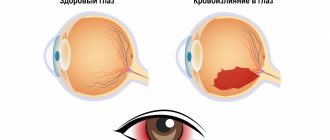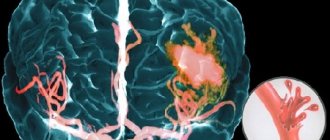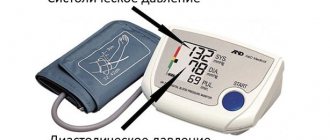A person receives up to 90% of information about the world around him through the organ of vision. The eye is a very sensitive organ; the eyes need to be protected and treated with attention to injuries and damage. Bleeding in the eye can occur at any age and for a variety of reasons. When is this a sign of pathology, and when can you do without a doctor? Why do complications develop, and can this be avoided?
First of all, hemorrhage is not a separate disease, but a symptom, sometimes indicating the presence of vascular or visual analyzer disease. If the pathology occurs against the background of injury or physical activity and is not accompanied by severe pain or visual impairment, then this situation is usually not dangerous. If additional symptoms are observed and the hemorrhage does not go away, you cannot do without the help of an ophthalmologist. Treatment depends solely on the cause of the problem and is prescribed only after examination.
Types of hemorrhage in the eye
Hemorrhage is damage to blood vessels, most often the smallest ones - capillaries. It leads to redness, the intensity of which depends not on the degree of damage, but on the location of the ruptured blood vessels.
Based on the part of the eye where the hemorrhage occurred, there are four types:
- Hyphema. This is the name for the accumulation of blood between the cornea and the iris - this space is called the chamber of the eye. Most often it occurs due to mechanical trauma with a blunt object. This type of hemorrhage is accompanied by severe pain, as well as blurred vision. When hyphema develops, urgent assistance from an ophthalmologist is required, otherwise complications are possible.
- Hemophthalmos. This is the name for hemorrhage localized in the vitreous body. The main symptom is a hazy haze before the eyes that does not disappear when blinking. If a lot of blood accumulates, complete loss of vision is possible. This type of hemorrhage is considered the most severe and dangerous. Vision loss can be irreversible; the likelihood of recovery depends on the speed of medical care.
- Subconjunctival hemorrhage is caused by damage to the vasculature of the mucous membrane. These hemorrhages often occur for no apparent reason and can develop against the background of chronic eye or vascular diseases.
- The accumulation of blood in the retinal area occurs due to damage to the retinal vessels. This area of the eye is the most sensitive and susceptible to damage. A small hemorrhage is enough to cause permanent visual impairment.
Only a specialist can determine which category a hemorrhage belongs to. Therefore, if typical symptoms appear, it is best to consult an ophthalmologist on the same day.
At CELT you can get advice from an ophthalmologist.
- Initial consultation – 3,900
- Repeated consultation – 2,000
Make an appointment
First aid
First aid for hemorrhage involves immediately calling an ambulance or going to an emergency room yourself. Before providing medical assistance, you should apply ice (any cold object) to the eye area.
It is forbidden to rub your eyes - this will increase the bleeding, and a possible infection that has penetrated into the blood will spread throughout the body.
You cannot use eye drops yourself or try to remove a foreign body. It is necessary to wait for the doctor, who will explain in detail the circumstances of the occurrence of the process, inform about existing diseases, allergies and medications taken.
Symptoms
Symptoms of hemorrhage also vary depending on the location of the damage.
When hyphema occurs, the following characteristic clinical picture develops:
- A red spot with smooth edges appears in the eye, it is evenly colored.
- The degree of coloration of the spot varies depending on the position of the body - lying or standing. This is due to the fact that blood can flow inside the anterior chamber of the eye.
- There is no loss of vision.
- Without help, the hemorrhage goes away on its own within a few days.
The symptoms of hemophthalmia vary greatly:
- Externally, hemorrhage is manifested by the presence of a brown spot with a uniform color.
- There is visual impairment. The severity depends on how badly the mucous membrane is damaged. With total hemophthalmos, complete loss of vision can develop.
- Flashes appear before the eyes, dark spots appear, often changing shape and size.
Hemophthalmos requires medical attention, because possible complications include retinal detachment and eye atrophy. And with surgical treatment, vision can be preserved.
Symptoms of retinal hemorrhage:
- A grid appears before your eyes, and moving dots appear - front sights.
- Objects appear blurry.
- Visual acuity decreases. Rarely does vision disappear completely.
It occurs against the background of orbital contusion (which is often a consequence of severe injuries in the eye area), as well as against the background of vasculitis and some systemic diseases.
If a lot of blood accumulates during hemorrhage, a condition called exophthalmos develops. The eyeballs begin to protrude forward, the patient feels restriction in eye movement. If the blood finds a way out, it can protrude under the eyelid and into the conjunctival sac.
There are symptoms that indicate specific damage and are used in diagnosis. For example, if the hemorrhage extends to the skin and resembles a spectacle frame, this indicates a fracture of the base of the skull.
State Description
“I’m crying with blood” – such complaints are rare, and therefore tears of blood cause panic. And there are reasons to worry. It is believed that hemolacria is a disease when there is bleeding from the eyes, but in fact it is a separate condition that accompanies other pathologies or diseases.
If blood comes from the eyes, it can be released from damaged tissues of the organs of vision, or along with tears. At low concentrations of blood particles in the tear fluid, the condition can remain almost unnoticeable. If a person literally cries blood, this indicates a significant amount of it.
Causes
There are different reasons:
- Injuries to the eye, orbit, or skull. Blunt, strong blows to the head are especially dangerous. After receiving such an injury (even if there are no symptoms), it is necessary to undergo an examination by an ophthalmologist.
- Infectious viral diseases. Hemorrhage occurs due to inflamed mucosa.
- Development of hypertensive crisis. A rapid increase in blood pressure can lead to disruption of the integrity of blood vessels. This happens especially often in older people or in patients suffering from diabetes or autoimmune diseases.
- Vomiting and severe coughing (physical strain) can lead to minor hemorrhage. Despite the fact that the redness of the eye can be severe, the condition is not classified as dangerous.
- Taking medications that reduce blood viscosity. These include the popular painkiller and antipyretic, aspirin, which is often taken in large doses and without a doctor’s prescription.
- Vitamin K deficiency. This is a rare pathology. Vitamin K is produced by the intestinal microbiota, and most often deficiency develops after massive antibiotic therapy or in chronic diseases of the immune system or gastrointestinal tract.
- Hereditary bleeding disorder - hemophilia.
The risk increases significantly in the presence of any chronic pathologies of the heart, blood vessels and internal organs, as well as in the first few weeks after eye surgery.
Hemorrhages can occur in children of any age: from newborns to adolescents. The reasons are basically the same as in adults.
Risk group
People at risk of intraocular hemorrhage include patients with hypertension and diabetes mellitus. These are patients who do not control blood pressure or sugar levels and do not receive constant rational therapy.
Therefore, they are at risk of not only vascular complications. Irrational and uncontrolled treatment also includes thoughtless use of blood thinning drugs. These categories of people need regular examination by specialized doctors and control of tests with due frequency.
The risk group includes people with the pathological conditions presented above. This also includes those who enjoy scuba diving. This is an extreme activity. Professional training is required before diving. This also applies to lovers of skydiving, ski jumpers and those involved in a more dangerous type of jumping from cliffs and from extremely high points. A full medical examination and appropriate permission are a prerequisite for engaging in such activities.
Professional athletes whose activities involve high speeds, running, fighting, and jumping are therefore at risk. They can get injured at the base of the skull (from a fall), or to the eyes (in martial arts, football players). Athletes and bodybuilders are in a state of constant physical overstrain. This is an additional risk factor for ocular hemorrhages.
People addicted to alcohol. Alcoholic drinks in large quantities cause aggression. People intoxicated often get involved in fights, which do not always end well.
No one is immune from neoplasms. Until now, it has not been possible to identify a reliable reason for the development of cancer cells in humans. Therefore, prevention consists of maintaining immunity, regular examinations by doctors for early detection of the tumor and its removal in the first stages of the disease.
People in stressful professions - doctors, lawyers, businessmen. Shop workers and miners are susceptible to the penetration of foreign bodies into the eyeball. It is very important for them to wear personal protective equipment when working. Workers in hot shops are exposed to changes in temperature and pressure, which also poses a risk of surges in intravascular pressure.
Recommendations for patients
When to see a doctor immediately:
- Redness occurred simultaneously in both eyes. This may be a sign of a serious circulatory problem.
- Loss or decreased vision in one or both eyes due to redness.
- Hemorrhage is accompanied by fog before the eyes, which does not go away within a few minutes or after blinking.
- Redness is accompanied by severe pain and impaired visual function.
- The hemorrhage occurred as a result of trauma. Shock often makes it difficult to determine the actual severity of the injuries sustained.
- Redness appeared due to taking anticoagulants.
If the hemorrhage is not accompanied by the listed symptoms, it is subconjunctival, and the patient knows the cause, then it is not necessary to consult a doctor. It is worth visiting an ophthalmologist if the redness does not go away within a few days.
What not to do in case of hemorrhage:
- Rubbing your eyes is not recommended - this will cause irritation, which may mask symptoms, and in some cases it may increase bleeding.
- Instill vasoconstrictors before consulting a specialist.
- Wear contact lenses.
- You cannot stop taking anticoagulants on your own. You should report hemorrhage to your doctor.
If hemorrhage appears in the eye, in any case, it is necessary to give the eyes rest, not to strain, and to avoid physical activity until there is a visible improvement.
As for prevention, there are no special measures that can protect against hemorrhage. Patients suffering from systemic diseases need to take prescribed medications and follow lifestyle recommendations. Patients with diabetes mellitus and hypertension should be observed by an ophthalmologist and attend preventive examinations.
Diagnostics
If you go to the doctor with the complaint “I’m crying blood,” he will prescribe an examination to identify the underlying disease or pathology. Diagnostics may include:
- Ultrasound of the visual organs;
- palpation and external examination of tear ducts, glands and sacs;
- radiography (including with contrast);
- samples (Schirmer, capillary);
- probing of tear ducts;
- CT or MRI of the brain;
- biomicroscopy;
- ophthalmoscopy;
- research of biomaterials (in this case it is a tear);
- blood tests.
When the reason why blood began to flow from the eyes is established, the ophthalmologist will prescribe therapy.
Treatment
Specific treatment consists of using eye drops to relieve redness. The drug is selected depending on the severity and cause of the hemorrhage. If a complication occurs, therapy is selected depending on the pathology that has developed. Glaucoma and cataracts require surgery.
It is important that treatment of hyphema includes avoiding taking certain medications. For example, it is not recommended to take non-steroidal anti-inflammatory drugs, as well as aspirin.
Therapy necessarily includes rest and rest for the eyes. And extensive hemorrhage with damage to the retina requires hospitalization.
You can undergo a full diagnosis from qualified ophthalmologists, choose the most effective treatment regimen and begin the path to recovery at the CELT multidisciplinary clinic.
Our services in ophthalmology
The administration of CELT JSC regularly updates the price list posted on the clinic’s website. However, in order to avoid possible misunderstandings, we ask you to clarify the cost of services by phone: +7
| Service name | Price in rubles |
| Appointment with an ophthalmologist (primary) | 3 900 |
| Comprehensive OCT examination of the retina (one eye) | 3 500 |
| Ultrasound scanning of the anterior segment of the eye | 1 000 |
| Revision of the vitreous cavity | 44 000 — 70 000 |
All services
Make an appointment through the application or by calling +7 +7 We work every day:
- Monday—Friday: 8.00—20.00
- Saturday: 8.00–18.00
- Sunday is a day off
The nearest metro and MCC stations to the clinic:
- Highway of Enthusiasts or Perovo
- Partisan
- Enthusiast Highway
Driving directions











